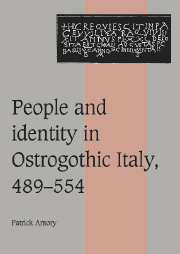Book contents
- Frontmatter
- Contents
- Preface
- List of rulers
- Terminology and vocabulary
- List of abbreviations
- Map of Ostrogothic Italy
- Introduction: Studying the barbarians in late antiquity
- 1 Ethnicity, ethnography and community in the fifth and sixth centuries
- 2 The Ravenna government and ethnographic ideology: from civilitas to bellicositas
- 3 Individual reactions to ideology I: names, language and profession
- 4 Complementary and competing ideals of community: Italy and the Roman Empire
- 5 Individual reactions to ideology II: soldiers, civilians and political allegiance
- 6 Catholic communities and Christian Empire
- 7 Individual reactions to ideology III: Catholics and Arians
- 8 The origin of the Goths and Balkan military culture
- Conclusion
- Appendix 1 The inquiry into Gundila's property: a translation and chronology
- Appendix 2 The Germanic culture construct
- Appendix 3 Archeological and toponymic research on Ostrogothic Italy
- Appendix 4 Dress, hairstyle and military customs
- Prosopographical Appendix: A prosopography of Goths in Italy, 489–554
- Bibliography
- Index
- Cambridge Studies in Medieval Life and Thought Fourth Series
Appendix 4 - Dress, hairstyle and military customs
Published online by Cambridge University Press: 03 December 2009
- Frontmatter
- Contents
- Preface
- List of rulers
- Terminology and vocabulary
- List of abbreviations
- Map of Ostrogothic Italy
- Introduction: Studying the barbarians in late antiquity
- 1 Ethnicity, ethnography and community in the fifth and sixth centuries
- 2 The Ravenna government and ethnographic ideology: from civilitas to bellicositas
- 3 Individual reactions to ideology I: names, language and profession
- 4 Complementary and competing ideals of community: Italy and the Roman Empire
- 5 Individual reactions to ideology II: soldiers, civilians and political allegiance
- 6 Catholic communities and Christian Empire
- 7 Individual reactions to ideology III: Catholics and Arians
- 8 The origin of the Goths and Balkan military culture
- Conclusion
- Appendix 1 The inquiry into Gundila's property: a translation and chronology
- Appendix 2 The Germanic culture construct
- Appendix 3 Archeological and toponymic research on Ostrogothic Italy
- Appendix 4 Dress, hairstyle and military customs
- Prosopographical Appendix: A prosopography of Goths in Italy, 489–554
- Bibliography
- Index
- Cambridge Studies in Medieval Life and Thought Fourth Series
Summary
Most of the cultural traits generally designated as Gothic are more correctly associated with the sixth-century Mediterranean military: Germanic names, some sort of Germanic language, the profession of soldier, a Balkan background, allegiance to a military king. Adherence to the Arian heresy, not a prerogative of soldiers, was not specific to people who might be called Goths under other ideologies.
It is therefore worth examining the few other specious “Gothic,” “barbarian” or “Germanic” cultural traits that historians have identified in sixth-century Italy. Long hair, beards, certain kinds of jewelry, military dress and military customs were not specific to people called Gothi. The evidence of pictures and the topoi used by texts ought to have made it obvious by now that such traits had become widespread not only in Italy, but throughout the Empire and its successor-states.
It is the Germanic culture construct, together with the classicizing picture presented by ethnographically influenced texts, that has prevented us from integating beards and long hair properly into the diverse professional and regional picture of the late Roman world. The frontier culture of Balkan warbands spread throughout the Mediterranean with the army whether that army paid allegiance to the emperors or not. Long hair was becoming an Empire-wide trait of military prestige at the same time that Germanic words were penetrating the koiné of imperial soldiers across the Mediterranean.
- Type
- Chapter
- Information
- People and Identity in Ostrogothic Italy, 489–554 , pp. 338 - 347Publisher: Cambridge University PressPrint publication year: 1997



